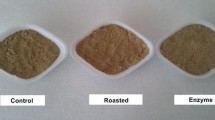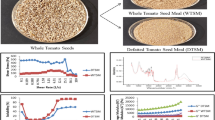Abstract
Capia pepper seeds are the mass waste of pepper utilization, and they have not commonly utilized as raw materials. In this study, the defatted press cakes (or meals) of cold oil pressed capia pepper seeds were evaluated. The pepper seeds were previously roasted and treated with enzymes (hemicellulase and protease) against control, before pressing. The compositional and functional properties of the defatted meals were determined. Moisture, protein, remaining oil, ash, L, a*, b* values and viscosity of the meals were measured by basic physicochemical analyses. Phytic acid, tannins and mineral contents were also determined. As functional properties, water-holding capacity, oil-holding capacity, emulsion activity, emulsion stability, foaming capacity, foam stability and the least gelation concentration were measured. The meals were shown to contain nutritionally important amounts of protein and minerals. For most functional properties, seed roasting caused some enhancements in the meals. Hence, defatted capia pepper seed meals can be utilized in food formulations due to their good nutritional and functional properties. This study points out the possibility and advantages of pepper seed meal valorization.
Graphical Abstract

(1) Capia pepper seed press cakes (meals) were used in this study. (2) Functional and physicochemical properties of the meals were measured. (3) The meals included good levels of proteins and some minerals. (4) The meals had functionalities for water and oil holding, emulsification and foaming. (5) The meals could be used in food formulations for enhanced functionalities.
Similar content being viewed by others
References
Galanakis, C.M.: Recovery of high added-value components from food wastes: conventional, emerging technologies and commercialized applications. Trends Food Sci. Technol. 26, 68–87 (2012)
Mirabella, N., Castellani, V., Sala, S.: Current options for the valorization of food manufacturing waste: a review. J. Clean. Prod. 65, 28–41 (2014)
TUİK: http://www.tuik.gov.tr/PreTablo.do?alt_id=1001 (2016). Accessed 03 May 2014
Bosland, P.W., Votava, E.J.: Peppers: Vegetable and Spice Capsicums. CABI Publishing, New York (2000)
Aybak, H.Ç.: Biber Yetiştiriciliği (Pepper Cultivation). Hasad Publishing Co., Istanbul (2002)
Bok, P.J.: Chemical component analysis of red pepper (Capsicum Annuum L.) seeds with various cultivars. J. Korean Soc. Food Sci. Nutr. 37, 1084–1089 (2008)
Embaby, H.E., Mokhtar, S.M.: Chemical composition and nutritive value of lantana and sweet pepper seeds and nabak seed kernels. J. Food Sci. 76, C736–C741 (2011)
Firatligil Durmus, E., Evranuz, O.: Response surface methodology for protein extraction optimization of red pepper seed (Capsicum frutescens). LWT-Food Sci. Technol. 43, 226–231 (2010)
Yılmaz, E., Arsunar, E.S., Aydeniz, B., Güneşer, O.: Cold pressed capia pepper seed (Capsicum Annuum L.) oils: composition, aroma and sensory properties. Eur. J. Lipid Sci. Technol. 117, 1016–1026 (2015)
Moure, A., Sineiro, J., Dominguez, H., Parajo, J.C.: Functionality of oilseed protein products: a review. Food Res. Int. 39, 945–963 (2006)
Sharma, G.M., Su, M., Joshi, A.U., Roux, K.H., Sathe, S.K.: Functional properties of select edible oilseed proteins. J. Agric. Food Chem. 58, 5457–5464 (2010)
Xu, Y., Hanna, M.A.: Nutritional and anti-nutritional compositions of defatted Nebraska hybrid hazelnut meal. Int. J. Food Sci. Technol. 46, 2022–2029 (2011)
Rodriguez-Miranda, J., Hernandez-Santoz, B., Herman-Lara, E., Vivar-Vera, M.A., Carmona-Garcia, R., Gomez-Aldapa, C.A., Martinez-Sanchez, C.E.: Physicochemical and functional properties of whole and defatted meals from mexican (Cucurbita pepo) pumpkin seeds. Int. J. Food Sci. Technol. 47, 2297–2303 (2012)
Hojilla-Evangelista, M.P., Selling, G.W., Berhow, M.A.: Extraction, composition and functional properties of pennycress (Thlaspi arvense L.) press cake protein. J. Am. Oil Chem. Soc. 92, 905–914 (2015)
Fıratlıgil Durmuş, E., Evranuz, O.: Kırmızı biber tohum unu ve proteininin çözünürlük ve emülsiyon özellikleri. ITU J. Eng. 9, 33–44 (2010)
Manamperi, W.A., Pryor, S.W., Chang, S.K.C.: Separation and evaluation of canola meal and protein for industrial bioproducts. An ASABE Section Meeting Presentation Paper Number: RRV-07116 (2007)
AOCS: Official Methods and Recommended Practices of the American Oil Chemists Society, 3rd edn. AOCS Press, Champaign (1984)
AOAC: Official methods of analysis of AOAC International, 17th edn. AOAC International, Gaithersburg (2002)
Khalid, E.K., Babiker, E.E., El Tinay, A.H.: Solubility and functional properties of sesame seed proteins as influenced by ph and/or salt concentration. Food Chem. 82, 361–366 (2003)
AOAC: Official methods of analysis of AOAC International. Official method 986.11, phytate in foods. AOAC International, Gaithersburg (1986)
Price, M.L., Van Scoyoc, S., Butler, L.G.: A critical evaluation of the vanillin reaction as an assay for tannin in sorghum grain. J. Agric. Food Chem. 26, 1214–1218 (1978)
Hagerman, A.E.: Vanillin Assay. http://www.users.miamioh.edu/hagermae/Vanillin%20Assay.pdf (2002). Accessed 03 May 2016
Moure, A., Dominguez, H., Zuniga, M.E., Soto, C., Chamy, R.: Characterisation of protein concentrates from pressed cakes of Guevina avellana (chilean hazelnut). Food Chem. 78, 179–186 (2002)
Wu, Y.V.: Emulsifying activity and emulsion stability of corn gluten meal. J. Sci. Food Agric. 81, 1223–1227 (2001)
Cano-Medina, A., Jiménez-Islas, H., Dendooven, L., Herrera, R.P., González-Alatorre, G., Escamilla-Silva, E.M.: Emulsifying and foaming capacity and emulsion and foam stability of sesame protein concentrates. Food Res. Int. 44, 684–692 (2011)
Kanu, P.J., Kerui, Z., Ming, Z.H., Haifeng, Q., Kanu, J.B., Kexue, Z.: Sesame protein 11: functional properties of sesame (Sesamum indicum L.) protein isolate as influenced by ph, temperature, time and ratio of flour to water during its production. Asian J. Biochem. 2, 289–301 (2007)
Minitab: Minitab 16.1.1 Statistical Software. Minitab Inc, State College, Pennsylvania (2010)
SPSS: SPSS Professional Statistics 10.1. Spss Inc, Chicago (1994)
Nas, S., Gökalp, H.Y., Ünsal, M.: Vegetable Oil Technology (Textbook). Pamukkale Univ. Pub. No: 005, Denizli, Turkey (2001)
Karaman, S., Karasu, S., Tornuk, F., Toker, O.S., Geçgel, Ü., Sagdic, O., Ozcan, N., Gül, O.: Recovery potential of cold press byproducts obtained from the edible oil industry: physicochemical, bioactive, and antimicrobial properties. J. Agric. Food Chem. 63, 2305–2313 (2015)
Foegeding, E.A., Davis, J.P.: Food protein functionality: a comprehensive approach. Food Hydrocoll. 25, 1853–1864 (2011)
Pomeranz, Y., Meloan, C.E.: Food Analysis: Theory and Practice. Chapman & Hall Pub. Co, New York (1994)
Inyang, U.E., Nwadimkpa, C.U.: Functional properties of dehulled sesame (Sesamum indicum L.) seed flour. J. Am. Oil Chem. Soc. 69–8, 819–822 (1992)
Eklund, A.: The contents of phytic acid in protein concentrates prepared from nigerseed, sunflower seed, rapeseed and poppyseed. Upsala J. Med. Sci. 80, 5–6 (1975)
Erdman, J.W.: Oilseed phytates: nutritional implications. J. Am. Oil Chem. Soc. 56, 736–741 (1979)
Adebowale, Y.A., Adeyemi, I.A., Oshodi, A.A.: Functional and physicochemical properties of flours of six mucuna species. Afr. J. Biotechnol. 4, 1461–1468 (2005)
Madhusudhan, K.T., Singh, N.: Effect of heat treatment on the functional properties of linseed meal. J. Agric. Food Chem. 33, 1222–1226 (1985)
Abbey, B.W., Ibeh, G.O.: Functional properties of raw and heat processed cowpea (Vigna unguiculata, walp) flour. J. Food Sci. 53, 1775–1777 (2006)
Narayana, K., Narasinga Rao, M.S.: Functional properties of raw and heat processed winged bean (Psophocarpus tetragonolobus) flour. J. Food Sci. 47, 1534–1538 (1982)
Hrčková, M., Rusnakova, M., Zemanovic, J.: Enzymatic hydrolysis of defatted soy flour by three different proteases and their effect on the functional properties of resulting protein hydrolysates. Czech J. Food Sci. 20, 7–14 (2002)
Author information
Authors and Affiliations
Corresponding author
Rights and permissions
About this article
Cite this article
Yılmaz, E., Hüriyet, Z., Arifoğlu, N. et al. Functional Properties of the Capia Pepper Seed Defatted Press Cakes. Waste Biomass Valor 8, 783–791 (2017). https://doi.org/10.1007/s12649-016-9602-5
Received:
Accepted:
Published:
Issue Date:
DOI: https://doi.org/10.1007/s12649-016-9602-5




